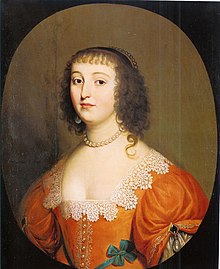Elisabeth of the Palatinate (1618–1680)
Elisabeth von der Pfalz (also Elisabeth von Böhmen, Elisabeth von Herford ; * December 26, 1618 in Heidelberg ; † February 8, 1680 in Herford ) was the eldest daughter of Elector Friedrich V of the Palatinate and his wife Elisabeth Stuart , Princess of England, Scotland and Ireland, and was from 1667 as Elizabeth III. Abbess of the imperial women's monastery in Herford .
Life
Elisabeth was the third of thirteen children of the Palatinate Elector, who played a tragic role as the Bohemian winter king from 1619 to 1620 at the outbreak of the Thirty Years' War , and his wife Elisabeth, a daughter of James I of England and sister of Charles I.
She was first raised in Heidelberg by her grandmother, Electress Luise Juliane , a born princess of Orange, who then brought her to her parents who had fled to Berlin after the Battle of White Mountain in 1620 . The parents soon moved on to exile in the Netherlands and initially left Elisabeth in the care of the Elector's Brandenburg court. From 1627 she lived with her parents in The Hague . After her father's death in 1632, she was raised by her mother. She turned to science at an early age and developed serious worldviews.
At times, the Polish King Władysław IV. Wasa wooed her hand. Władysław withheld the papal rejection from the senate (November 1634) and then received the approval of the senate for this marriage (March 1635). Thereupon he demanded in vain (June 1635) the conversion of the princess.
She was in contact with Anna Maria von Schürmann , then with René Descartes , became his most ardent pupil and was in lively correspondence with him until his death, from which among other things his treatise Les Passions de l'âme arose. In her family, she was considered a difficult blue stocking to marry . In 1651 she followed her youngest sister Sophie , who later became Electress of Hanover, to the court of her brother Karl Ludwig at Heidelberg Castle . In the violent marital disputes between her brother and his wife Charlotte von Hessen-Kassel and their subsequent divorce, she, unlike Sophie, sided with her sister-in-law.
After she married for a long time at the court of her cousin, Elector Friedrich Wilhelm von Brandenburg , and then in Kassel with her cousin Hedwig Sophie. Landgravine von Hessen-Kassel, she was elected coadjutor of the Imperial Abbey of Herford in 1661 and abbess in 1667 . Since she had meanwhile turned more and more to an enthusiastic and mystical direction, she took in 1670 Labadists , then Quakers as well, in Herford. Their mystical eccentricities, however, aroused great offense among the Lutheran population.
Elisabeth was buried in Herford Minster .
Monument and namesake
A memorial was erected for her in the city of Herford on Elisabethstrasse, which is named after her. The artist Wolfgang Knorr created the bust. In addition, a Herford vocational college for social and health care sponsored by the Herford parish is named after her.
The Elisabeth of Bohemia Prize has been awarded since 2018 .
Letters
- René Descartes: The correspondence with Elisabeth of the Palatinate . French German. Translated by Isabelle Wienand, Olivier Ribordy and Benno Wirz, with the assistance of Angela Schiffhauer. Hamburg: Meiner 2015. ISBN 978-3-7873-2478-1
literature
- Helge bei der Wieden : A castle on the moon and a supply in Westphalia. The way of the Countess Palatine Elisabeth to Herford. In: Historical yearbook for the Herford district. Volume 6, 1997, pp. 7-38.
- Helge bei der Wieden (Ed.): Elisabeth von der Pfalz, Abbess of Herford, 1618–1680. A biography in individual representations (= publications of the Historical Commission for Lower Saxony and Bremen. Volume 245). Hahn, Hannover 2008, ISBN 978-3-7752-6045-9 ( review ).
- Sabrina Ebbersmeyer (ed.): The correspondence between Elisabeth von der Pfalz and René Descartes . Paderborn 2015.
- Peter Fuchs: Elisabeth. In: New German Biography (NDB). Volume 4, Duncker & Humblot, Berlin 1959, ISBN 3-428-00185-0 , p. 447 f. ( Digitized version ).
- Ludwig Hölscher : Elisabeth, Countess Palatine near the Rhine . In: Allgemeine Deutsche Biographie (ADB). Volume 6, Duncker & Humblot, Leipzig 1877, pp. 22-28.
- Marita A. Panzer: Wittelsbach women. Princely daughters of a European dynasty. Pustet, Regensburg 2012, ISBN 978-3-7917-2419-5 , pp. 84, 90-94.
Web links
- Literature by and about Elisabeth von der Pfalz in the catalog of the German National Library
- Biography in the Westphalian History portal
- Lisa Shapiro: Elisabeth, Princess of Bohemia. In: Edward N. Zalta (Ed.): Stanford Encyclopedia of Philosophy .
- Maren Gottschalk : December 26th, 1618 - birthday of Elisabeth von der Pfalz WDR ZeitZeichen from December 26th, 2018 (podcast)
Individual evidence
- ↑ Stanford Encyclopedia of Philosophy, ed. 2013
- ↑ Dirk Van der Cruysse: Being a Madame is a great craft. Liselotte of the Palatinate. A German princess at the court of the Sun King. From the French by Inge Leipold. 7th edition, Piper, Munich 2001, ISBN 3-492-22141-6 , p. 42ff.
- ↑ Dirk Van der Cruysse, ibid., P. 46
| predecessor | Office | successor |
|---|---|---|
| Elisabeth Louise Juliane of Pfalz-Zweibrücken |
Abbess of Herford 1667–1680 |
Elisabeth Albertine of Anhalt-Dessau |
| personal data | |
|---|---|
| SURNAME | Elisabeth of the Palatinate |
| ALTERNATIVE NAMES | Elisabeth of Bohemia; Elisabeth of Herford |
| BRIEF DESCRIPTION | eldest daughter of Elector Friedrich V, abbess of Herford |
| DATE OF BIRTH | December 26, 1618 |
| PLACE OF BIRTH | Heidelberg |
| DATE OF DEATH | February 8, 1680 |
| Place of death | Herford |

